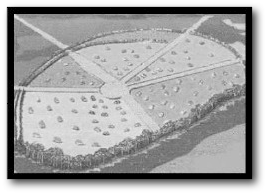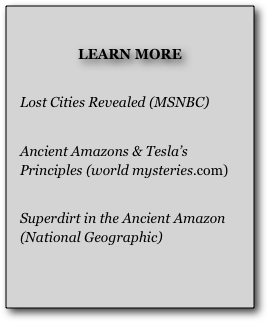



FAWCETT VINDICATED?
Through the years as Fawcett surveyed and explored the Amazon Basin he continually turned up evidence of former human settlements: bits of pottery, drawings and carvings of animals and symbols on stone, and signs of roads. Most of the relics were found in areas of raised ground, or mounds. Together with stories and legends told by a surprising number of Indian groups, the evidence pointed to a likelihood of some long-vanished civilization that extended over a vast portion of the Basin.
What has long been ignored by skeptics is the testimony given by 16th century Spanish and Portuguese explorers, who reported enormous populations of indigenous people along the banks of the Amazon River and in other areas; more people than has been assumed, even in modern times, could be supported by the poor rainforest soil and the difficult climatic conditions. Their reports have been written off as fantasy, along with tales of El Dorado-- the great Inca leader who literally covered himself with gold.







An interesting legend is that of the crowing rooster, or canto galo, as a sign there are subterranean cities nearby. Some people in Brazil and elsewhere insist there are numerous underground cities, and their beliefs have occasionally been supported by reports from researchers and others claiming to have stumbled across hidden entrances, tunnels, or caves leading to human settlements.
Many Buddhists believe in an underground world known as Shamballah.

TERRA PRETA
For many years, native people of the Amazon region have known about a special type of rich, dark soil to be found here and there, and in these areas they planted their crops when feasible. Scientists have found this super-fertile soil to be self-renewing; that is, it never needs to lie fallow or to have other organic materials added. In addition, crops grown in it are quite rich in nutrients.
It’s assumed this soil, full of ceramic fragments and charcoal, was somehow created by humans of a civilization that existed in the distant past. The implication is that the region could indeed have supported a far greater population than previously thought possible.
Considering that experts in the field are gathering increasing evidence of sophistication in ancient road-building, managed lands, and agriculture, perhaps it’s time to reevaluate both the “legends” and theories of those who journeyed in the wilderness long before the existence of satellites, GPS, and presumptions of a strictly linear evolution of civilization.
